
Introduction: A Smarter Way to Organize Visual Tests
Visual testing helps catch changes in a website’s design or layout, but it often creates hundreds of screenshots that are hard to manage. Percy is a popular tool for visual testing, and now it has a new feature — Test Case Based Grouping — powered by Genqe.ai. This feature helps organize screenshots based on the test case they belong to, not just the page or component. This means it’s easier to understand what each visual change affects. It saves time, reduces confusion, and helps teams review only the most important changes.
What is Test Case Based Grouping?
This feature automatically groups screenshots by the actual test cases used in testing, not just by page or layout. For example, if you test a login page, all screenshots related to that login test are grouped together — even if the page has multiple elements. This makes it easier to track visual issues related to specific functions or features. Instead of seeing a long list of screenshots, you get a clean view grouped by user flows. It brings more structure and clarity to the visual testing process.
Why This Feature Matters
When testing many parts of an app, it’s easy to get overwhelmed by dozens or even hundreds of screenshots. Reviewing each one manually wastes time and can lead to missed issues. With Genqe.ai’s Test Case Based Grouping, your test results are easier to manage. You can see which changes affect critical parts of your app, like payment or signup. It also helps teams focus on reviewing high-priority test cases first. This improves communication between QA, developers, and product managers by showing how each test connects to real features.
How Genqe.ai Makes It Work
Genqe.ai adds smart technology behind the scenes to make Test Case Based Grouping possible. It reads your test cases using AI, understands their purpose, and matches each screenshot to the right test. Genqe.ai doesn’t just group screenshots based on file names or tags — it uses machine learning to understand the meaning of tests. It also learns from your test history to improve future grouping. This automation means less manual work and fewer errors. The result is a smarter, more organized way to review visual changes.
Understanding Test Case Intent
Genqe.ai uses natural language processing (NLP) to understand what your test cases are trying to do. For example, if a test case checks if users can sign in, Genqe.ai knows that screenshots taken during that test belong together. Even if your test cases are written in plain English or in code, Genqe.ai understands the goal. This helps it group the right screenshots under the right test case. By understanding the intent behind the test, it makes the visual results more meaningful and easier to review.
Smarter Screenshot Grouping
Genqe.ai doesn’t just look at the page title or buttons — it analyzes screenshots, code, and user actions. It can tell when screenshots are part of the same test, even if they’re from different devices or browsers. For example, it can group desktop and mobile views of a checkout page under one test case. This gives teams a complete view of each feature’s visual performance. This smart grouping saves time, avoids confusion, and improves test accuracy across different platforms and environments.
Highlighting What Matters
Traditional visual testing tools show every pixel difference — even small ones that don’t matter. Genqe.ai helps reduce this noise by showing only important changes. It looks at the test case’s purpose and highlights differences that affect function or design. For example, a color change in a logo might not be critical, but a missing button on a payment form is. Genqe.ai helps you focus on the changes that really impact your users, which means you can make faster, smarter decisions during code reviews.
Easy Integration with Your Tools
Test Case Based Grouping works smoothly with your existing tools. Genqe.ai connects Percy with popular test management platforms like Jira, TestRail, and others. This means each test case in Percy can link directly to your user stories or bug reports. It also works with CI/CD tools like Jenkins or GitHub Actions, so test results show up in your development pipeline automatically. With this easy integration, your team gets a full picture of how visual testing fits into the software development process.
Real-World Example
Imagine an online store releasing a new checkout design. Without Genqe.ai, the QA team sees over 200 screenshots in Percy, grouped by pages like “Cart,” “Payment,” and “Summary.” It’s hard to tell which screenshots belong to the same test. With Test Case Based Grouping, all screenshots related to the “Checkout Flow” test case are grouped together. This helps the team focus on changes that affect user checkout directly. Reviewers spot a missing payment button quickly and fix it before release. The process becomes faster, clearer, and more efficient.
Benefits for Your Team
Test Case Based Grouping offers many advantages. It helps QA teams stay organized, saves time during reviews, and highlights the most important issues. Developers can clearly see what part of the code affects what visual changes. Product managers can track feature coverage more easily. Even non-technical team members can understand test results better. With fewer mistakes and more visibility, everyone on the team works smarter. Genqe.ai helps bring your whole QA process together in one clear, intelligent system.
Conclusion: Smarter Testing Starts Here
The new Test Case Based Grouping feature on Percy, powered by Genqe.ai, is a big step forward in visual testing. It helps teams organize tests by what really matters — features and user flows. No more messy screenshots or guessing what changed. Genqe.ai brings structure, intelligence, and automation to your visual QA process. It saves time, reduces errors, and makes releases smoother. If your team wants better results with less effort, now’s the time to explore this feature. Smart QA is the future — and Genqe.ai is leading the way.